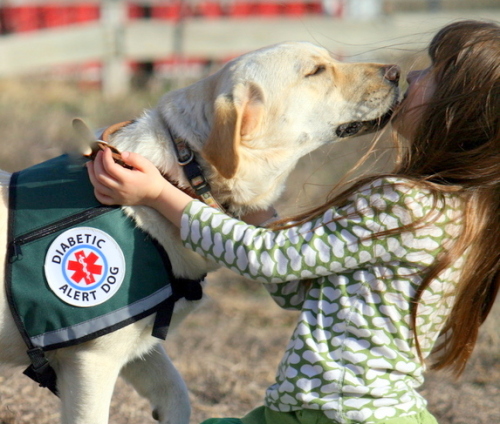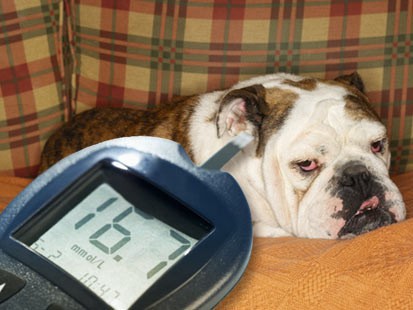Has your pet dog been diagnosed with diabetes? There is a growing epidemic of diabetes among pets and pet owners should be able to identify and manage the disorder as early as possible in order to save their pets [1].

The diabetic epidemic in pets is spreading at an alarming rate. It is estimated that out of every 160 dogs, 1 suffers from diabetes. Most of the conditions of diabetes that are diagnosed in dogs are Type I Diabetes as found in humans, wherein the auto immune system of the body ends up attacking the beta cells of the pancreas. This leads to no insulin being produced by the body. There is no evidence of Type II Diabetes occurring in dogs although there have been some reported cases of the disorder in cats.
The pathology of diabetes in dogs is similar to humans. Diabetes mellitus or sugar diabetes is the condition in which dog’s body is not able to make or process insulin. Due to this, there is increase in the blood sugar levels, thus leading to this metabolic disorder called sugar diabetes or diabetes. While diabetes mellitus cases in dogs can range from mild to severe, this disorder in dogs is usually manageable, but if it is not treated at the right time, it can lead to several complications such as malnutrition, weakness in the legs, cataract and many other disorders and can prove to greatly interfere with the quality of life of the diseased animal. Cataract is one of the most common disorders and symptoms associated with diabetes in dogs. Diabetes is much more common in female dogs as compared to male dogs.
Commonly affected breeds of dog by Diabetes
While diabetes can affect any breed of dog at any age, it is much more prevalent in middle aged and older dogs of some breeds. Some of the breeds of dogs which are more susceptible to diabetes include the following:
- Pomeranians
- Golden Retrievers
- German Shepherds
- Siberian Huskies
- Labrador Retrievers
- Fox Terriers
- Schnauzers
- Poodles
- Keeshonden
- Spitz
- Bichon Frise
The mean age at which this diabetic condition develops in these breeds is when they are about 4-14 years old. Genetics play a major role in dogs and the primary reason of this condition developing in dogs is not known.

It is estimated that almost half of the cases of diabetes in dogs are due to autoimmune disorders which prove to cause damage to the pancreas. Type II Diabetes cases in canines is generally uncommon and is much more common among felines. There are, however, a few reported cases of canines developing resistance to the effects of insulin on the body. This is usually caused because of some other underlying condition which causes the body to develop this resistance, such as Cushing’s disease.
While obesity is a high risk factor for diabetes in humans, there is no proven evidence that the case is the same for canines [2]. Obesity, however, can cause the body to develop a slight resistance to insulin, but typically, it is not one of the foremost risk factors which cause diabetes in canines. Gestational diabetes is also common in many canines, but this usually disappears after delivery of the babies.
Signs and Symptoms of Diabetes in Dogs
As pet owner, you should be aware of the signs and symptoms of this condition. The symptoms at which you should take caution include the following:
- Polyuria or frequent urination in dogs.
- Polydipsia or increased thirst wherein the dog drinks larger amounts of water than usual.
- Polyphagia or the condition of hunger pangs and having a much larger appetite than usual.
- Malnourishment despite the larger appetite with an accompanied loss of weight and appearance is common in cases of diabetes in dogs.
- Clouding of the eyes and an acute onset of cataract is also an indication of diabetes in dogs.
If you find these symptoms in your dog, then you should visit the veterinarian and get this disorder treated at the earliest. If the symptoms and signs go unnoticed, there may be several complications and these may even prove to threaten the life of your pet.

Diagnosis of Diabetes in Dogs
The diagnosis of diabetes in dogs can be done very easily with simple tests to determine the concentration of glucose or sugar in the blood stream and also the urine. The presence of ketones in the urine is also an indicator of diabetes.
An elevated cholesterol level, the presences of an excess of triglycerides, hyperlipidemia, an increased level of liver enzymes and an enlarged liver, high specific gravity of urine, an increased count of white blood cells and a low level of phosphorus in the blood and urine are also some of the diagnostic test results that are usually accompanied with diabetes [3].
While the cases of diabetes in canines can range from severely complicated to mild, most of the cases are moderate and do not require any hospitalization. Proper home care is adequate in order to treat the dog of this disease.
Complications of Diabetes in Dogs
Diabetes in canines can present a range of complications including a number of degenerative diseases and infections. Some of the common complications associated with diabetes in dogs include the following:
- Nephropathy or fibrosis occurring to the kidney tissues. This tends to damage the kidneys greatly. The cause of kidney nephropathy is the increased stress put on the nerves and the blood vessels by the excess amounts of sugar in the blood stream.
- Infections including urinary tract infections are quite common in diabetic canines. This happens due to the impairment of both the circulatory system as well as the immune system of the body. Infections may occur on the teeth and the gums of dogs as well.
- A hepatic disorder involving the liver is also common in dogs with diabetes. The liver is the organ which is responsible for converting food into blood sugar and many diabetic dogs show and enlarged liver with an elevated production of enzymes.
- Hyperthyroidism and hyperadrenocorticism are also complications associated with diabetes if the disease is left untreated.
- Cataract in dogs is one of the most common complications that are associated with diabetes. The increased glucose levels in the blood can prove to damage the delicate blood vessels in different parts of the body and the eyes are most prone to being damaged.
- Ataxia or the loss of balance and coordination is also associated with diabetes in dogs. Diabetic canines may also exhibit lethargy, dizziness, confusion and trembling due to the excessive amounts of glucose in the blood stream.
- Excessive dehydration may also lead to seizures and loss of consciousness. Dehydration can easily be caused despite drinking fluids as there is a lot of urine being excreted out in order to get rid of the excess glucose concentration.
Management of Diabetes in Dogs
Early diagnosis of diabetes may lead to prevention of cataract or any kind of neuropathy conditions in your loving pet [4]. You should know how to manage these conditions in your pet and show your warm love to your pets. Your main goal while managing this condition is to maintain glucose levels regulated and try to do away with symptoms of this condition such as excessive drinking and urination. The condition is definitely much more manageable if you change the diet and induce healthy lifestyle in your dog apart from regular insulin injections.

When it comes to following a treatment plan or to administer medications for diabetes in dogs, the veterinarian must be consulted before the procedure commences.
Since Type II Diabetes in canines is unheard of, diabetic dogs must be treated with similar methods that are used to treat Type I Diabetes in humans. This means that external administration of insulin or insulin analogues should be provided to the dog in order to make up for the lack of physically produced insulin by the pancreas. If canines are provided with the medications for Type II Diabetes such as some oral medications, the dogs unfortunately do not show any positive response.
Some of the effective methods for the management of diabetes in dogs include the following:
- Insulin injections: Your diabetic dog may require insulin injections almost every day to regulate and maintain blood glucose levels in its body. Every breed of dog needs different amount of insulin, so go with your veterinarian advice and give the correct dose of insulin to your diabetic pet. You should learn to administer the insulin in your dog’s body if daily dose is required, as is often the case.
- A healthy and regular diet: The diet should be of high protein and high fiber content so that glucose gets metabolized in an efficient way. Try to feed your dog same food every day and at the same time. Take your veterinarian recommendation before feeding your diabetic dog.
- Regular exercise is also highly recommended for a diabetic walk. You should ensure to take your pet dog out on walks and the dogs should receive as much physical activity as possible as this raises the sensitivity of the body to the insulin hormone. The amount of daily exercise should be consistent.
- Glucometers and urine strips are often used in order to monitor the glucose levels in both the blood stream and also in the urine. These devices need to be used frequently in order to determine whether the blood sugar levels are in check after the administration of insulin and healthy lifestyle measures.
Some of the general guidelines that should be followed in managing diabetes in pets include:
- Maintaining a balance between carbohydrate consumption and the amount of insulin in the blood. Complex carbohydrates and foods that have a low glycemic index are recommended for diabetic dogs.
- Maintaining a moderate level of fiber in the diet is recommended. A mix of both soluble and insoluble fibers should be included in the diet. Excess of soluble fibers can cause gas and diarrhea while an excess of insoluble fiber can result in a loss of appetite, constipation and vomiting.
- Maintaining protein levels in the diet. While this is not necessarily a requirement, diabetic dogs often tend to lose weight and muscle mass and as such; a protein rich diet can prove to be helpful.
- Maintaining a regular and consistent diet, particularly in terms of carbohydrate consumption. Simple carbohydrates which can be quickly digested and have a high amount of sugar should be avoided in a diabetic dog’s diet.
- Getting adequate amount of physical activity for the dog is recommended. However, care must be taken not to over exert the pet dog and also to maintain a regular and consistent amount of physical activity. It is recommended that diabetic dogs get at least 20 to 30 minutes of exercise before a meal and before the administration of insulin.
- Often, some dietary supplements such as L-Cartinine, Zinc, Chromium, Probiotics, digestive enzymes and omega 3 fatty acids may be prescribed. However, a veterinarian’s opinion or recommendation must be obtained before administering dietary supplements.
- In severe cases of hypoglycemic episodes in canines, glucose or infusions of glucagon may be administered to the diabetic canine. However, this must only be done in extremely severe cases and must always be carried out under professional medical recommendation and supervision.

It is essential to frequently monitor the blood sugar levels in order to determine whether the treatment procedure is effective [5]. Diabetes in dogs can be easily managed if the signs and symptoms of the disease are diagnosed early and appropriate measures are taken.
Caring for a pet dog which has been diagnosed with diabetes can prove to be really stressful, expensive and also time consuming. However, if managed effectively, the condition can be treated and the pet dog can lead a healthy and normal life.
The prognosis of diabetic dogs is generally good if the diagnosis of the disease was done early before any damage or complications could occur. As such, with proper treatment and monitoring of blood sugar conditions, the quality of life of the pet dog can be greatly improved and it can lead a much closer to normal life.
References
[1] Metabolic Dysregulation With Atypical Antipsychotics Occurs in the Absence of Underlying Disease A Placebo-Controlled Study of Olanzapine and Risperidone in Dogs, Marilyn Ader, Stella P. Kim, Karyn J. Catalano,; vol. 54 no. 3 862-871 – March 2005 – DOI: 10.2337/diabetes.54.3.862, http://diabetes.diabetesjournals.org/content/54/3/862.short
[2] ALLOXAN DIABETES IN THE DOG, William S. Lynn.,; Volume 33, Issue 5 – July 01, 2013 – DOI: 1210/endo-33-5-297, http://press.endocrine.org/doi/citedby/10.1210/endo-33-5-297
[3] Pregnancy diagnosis and abnormalities of pregnancy in the dog, Margaret V. Root Kustritz,; Volume 64, Issue 3, Pages 755–765 – August 2005 – DOI: 1016/j.theriogenology.2005.05.024, http://www.sciencedirect.com/science/article/pii/S0093691X05001871
[4] Diabetes Mellitus and the Dental Pulp, I.B. Bender, DDS, A.B. Bender, MD,; Volume 29, Issue 6, Pages 383–389 – June 2003 – DOI: 10.1097/00004770-200306000-00001, http://www.sciencedirect.com/science/article/pii/S0099239905610497
[5] Treatment of type I diabetes using encapsulated islets, Patrick Soon-Shiong,; Volume 35, Issues 2–3, Pages 259–270, – 1 February 1999 – DOI: 1016/S0169-409X(98)00076-3, http://www.sciencedirect.com/science/article/pii/S0169409X98000763
